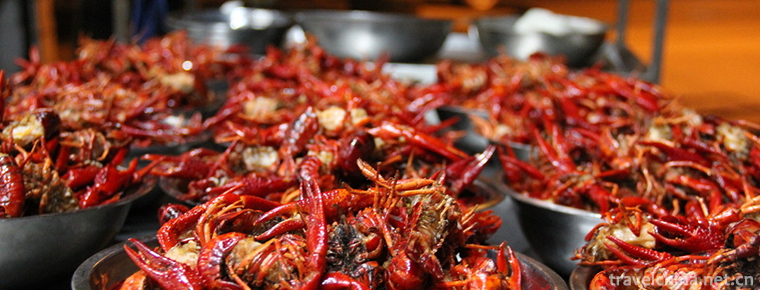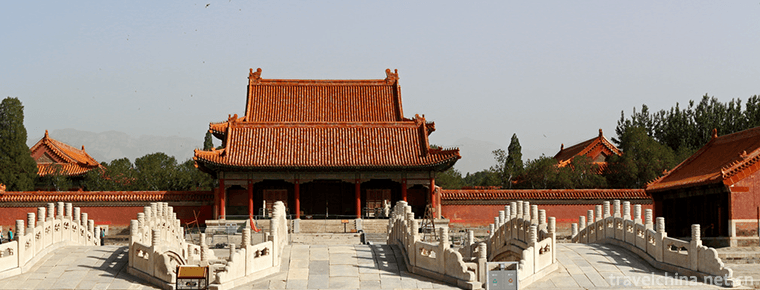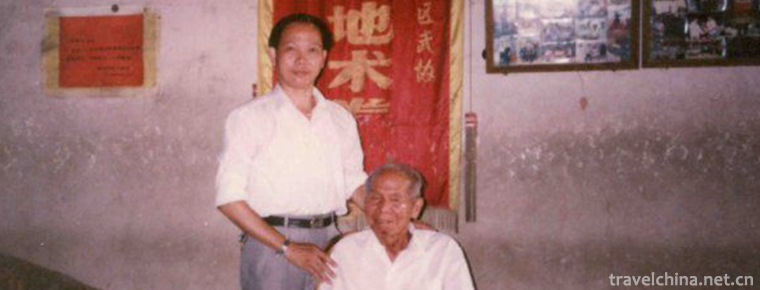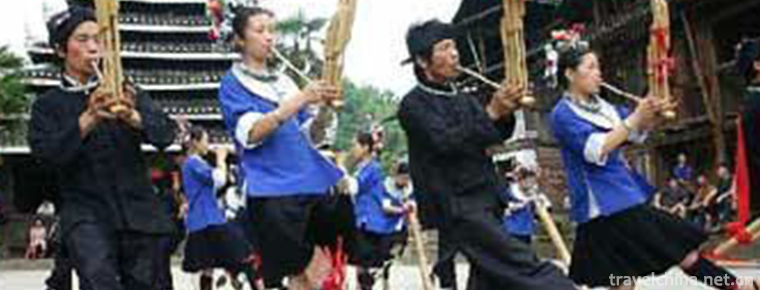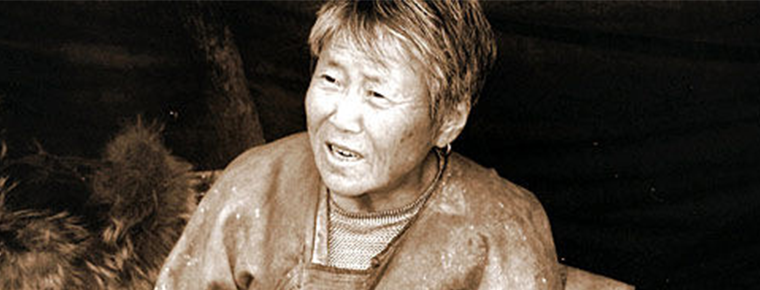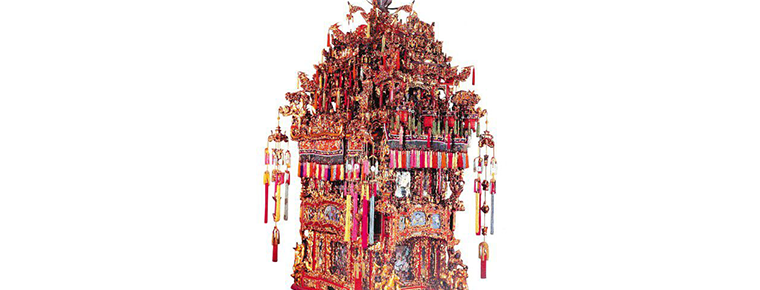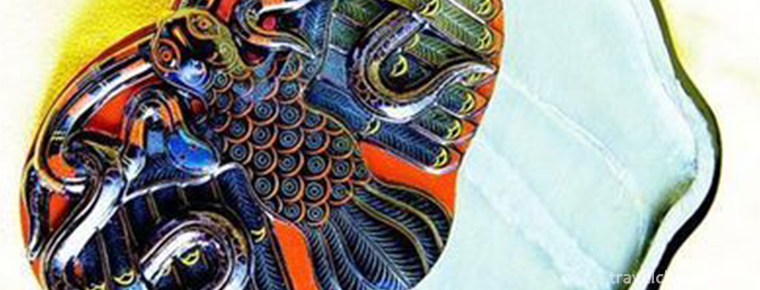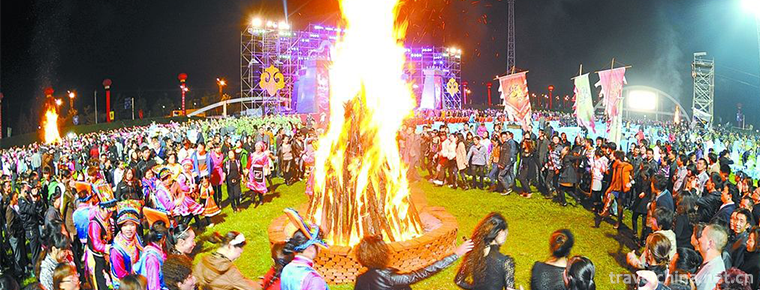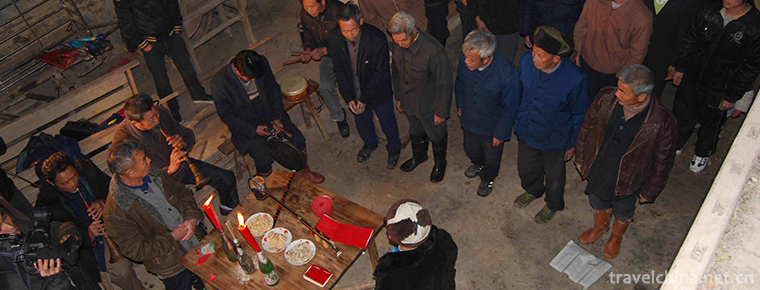Gu embroidery
Gu embroidery
Gu embroidery, a traditional folk art in Shanghai, is one of the national intangible cultural heritages.
Gu embroidery originated in Jiajing period of Ming Dynasty. Lu Xiangyuan patron's concubine, Miu Shi, was good at embroidering figures and Buddha statues, and Gu Daughter-in-law, Han Shi, imitated Song and Yuan Dynasty paintings into embroidery, with delicate silk splitting and vivid embroidery. Gu embroidery exquisite, peers can not expect its back, skillful people, it is strange. Gu embroidery is mostly household scarlet, known as "Han Yuan embroidery", which is basically used for household collections or gifts.
On May 20, 2006, Gu Embroidery was approved by the State Council of the People's Republic of China to be included in the first batch of national intangible cultural heritage lists with the heritage number_-17.
historical origin
Gu embroidery, also known as "Luxiang Garden Gu embroidery", is one of the traditional embroidery techniques of the Han nationality. Gu embroidery got its name because it originated from Gu Ming family in Songjiang area of Ming Dynasty. According to legend, Gu embroidery method came from the palace, Gu family has appeared Miao family, Han Ximeng and Gu Lanyu, and other Gu embroidery masters.
In the Qing Dynasty, Gu Mingshi's great-granddaughter, Gu Lanyu, began to set up embroidery workshops to collect and migrate widely to teach Gu embroidery techniques. Since then, Gu embroidery has spread in the vicinity of Shanghai. Folk women are competing to imitate it. Businessmen set up embroidery houses and bought embroidery. Gu embroidery's name has spread all over the south of the Yangtze River. After Jiaqing period of Qing Dynasty, Gu embroidery gradually declined and was almost lost.
Shanghai Luxiang Garden is located in Songjiang Prefecture. The Songjiang people have been restoring Gu embroidery as their duty. In the 1920s, Songjiang charity set up "Songyun Women's Vocational School" and "Women's Embroidery Class" from the first grade of primary school to the third grade of junior middle school. Unfortunately, the school was destroyed by the artillery fire of the Japanese invaders and never recovered.
By the 1970s, in response to Comrade Zhou Enlai's instructions on the excavation and development of traditional Chinese arts and crafts, Songjiang Crafts Factory began preparations for the restoration of Gu embroidery art at the end of 1972. Dai Mingjiao, who had studied Gu embroidery skills in Songyun Women's School in the 1920s and 1930s, was employed to teach apprenticeship. Shortly afterwards, because of political movements such as the "Cultural Revolution", Gu embroidery, which had just recovered, died on the charge of "retro-vintage".
After the Third Plenary Session of the Eleventh Central Committee of the Communist Party of China in 1978, Songjiang Technological Factory set up Gu Embroidery Group to resume the research, teaching and production of Gu Embroidery. Later, Songjiang Handicraft Factory formally established Gu embroidery workshop to organize production. Songjiang Gu embroidery artists continue to create a number of exquisite, elegant and flowing Gu embroidery new works. Gu embroidery, like dry seedlings bathing in rain and withered trees in spring, began to show vigor and vitality.
Cultural characteristics
Gu embroidery's unique embroidery techniques are mainly embodied in:
Half-painting and half-embroidery, combination of painting and embroidery
Gu embroidery takes the masterpieces of landscapes, flowers, birds and figures in famous paintings of Song and Yuan Dynasty as its copy. The pictures are all combined with embroidery and painting, and embroidery is the most unique feature of Gu embroidery. For example, in the Axis of Congratulations on the Birthday of the Immortals, the figures in the painting wear brocade clothes, first with background color, then with embroidery as brocade pattern on the background color; the faces of the characters are embroidered first and then painted, while the clouds and mists are painted directly with color without embroidery. This bold and innovative technique is particularly vivid in expressing landscapes and characters.
The needle method is changeable and innovative.
Gu embroidery's needling method is complex and changeable. Generally, there are more than ten kinds of needling methods, such as uniform needling, laying needle, seed-punching needle, joint needle, nailing gold, single set needle, scaling needle and so on.
Inter-color halo, complementary color matching
Gu embroidery uses a variety of colorful embroidery lines, which are not seen in the Song embroidery except the middle color lines. "Gu embroidery" in order to more vividly display the rich color effect of landscape characters, insects, fish, flowers and birds, etc., uses various intermediate tones such as tenderness, depth and shade of scenery color to complement and set colors. Thus, the natural scenery of the original material can be fully displayed.
Gu embroidery is different from the four famous embroidery works of Su, Guangdong, Hunan and Shu from the beginning. It specializes in embroidery of calligraphy and painting and becomes a unique art. It combines traditional needling in Song embroidery with Chinese brushwork, substitutes needle for brush, substitutes line for ink, and combines halo and dyeing. It adds splendor to the splendid culture and art of the motherland.
Production process
The first process of making Gu embroidery is to select a copy of the blueprint, often based on literati paintings such as landscapes, flowers and birds, figures and so on. The second process is to lay the embroidery cloth flat on the bright glass case according to the painting, draw lines with brushes, prepare for "line color" later, and prepare silk lines of different colors to simulate various colors in the original painting. If the pen is insufficient, the needle can be original; if the ink is dizzy, the thread can be filled. In this way, the ink can be replaced by thread, and the dyeing can be dotted and muddy.
Theme works
Gu embroidery theme mainly involves famous paintings, landscapes, figures, flowers and birds, etc. Gu embroidery in the landscape, figures, flowers and Birds Charm vivid, delicate and unparalleled, thus known as "painting embroidery". The main representative works are "fish and algae picture", "horse wash picture", "female queen picture", "rice painting landscape map", "Huaxi fishing hidden map" and so on.
Inheritance and protection
Inheritance value
Gu embroidery, originated in Luxiangyuan, Shanghai County, Songjiang Prefecture in Ming Dynasty, is based on famous paintings and known as the "ancestor of embroidery art". In the first batch of national intangible cultural heritage, folk Gu embroidery artists cut 36 silks with a thread for embroidery, featuring the combination of painting and embroidery, and assisted by painting. Often in an afternoon, only one feather on a bird can be embroidered, which is extremely exquisite. Fine. "
In the history of Chinese embroidery technology, Gu embroidery in Ming Dynasty is really famous for its painting embroidery and has a great influence on its development. Gu embroidery is famous for its exquisite technique, elegant form and high artistry. Up to the Qing Dynasty, there were four famous embroidery stitches: Su embroidery, Guangdong embroidery, Hunan embroidery and Shu embroidery. Although they had their own characteristics, they also had the advantages of skillfully learning and using Gu embroidery.
Gu embroidery, the only embroidery art genre in the south of the Yangtze River, has experienced 400 years of prosperity and decline, even death and rebirth, which is a miracle in the history of Shanghai folk embroidery.
Inheriting characters
Dai Mingjiao, female, Han nationality, born in Shanghai in 1922. The first batch of national intangible cultural heritage projects are representative inheritors of Gu embroidery.
protective measures
In 2003, China National Folk Culture Conservation Project launched the declaration of pilot projects. One project in the field of Folk Quyi in Shanghai was selected into the second batch of national pilot projects. At the same time, two pilot projects at the municipal level were established. Gu embroidery is one of the pilot projects at the municipal level.
In February 2005, Shanghai Wenguang Film and Television Administration also took the lead in granting "art allowances" to a group of folk artists throughout the country. 27 old folk artists from Nanhui Gong and drum books, Qingputian folk songs and Gu embroidery were the first to receive allowances.
social influence
Important activities
In May 1987, Songjiang Museum held Gu Embroidery Art Exhibition with the support of Songjiang Crafts Factory to introduce the history and new life of Gu Embroidery to the world.
In 2009, the China Weaving and Embroidery Exhibition, held in Hangzhou, showcased Gu Embroidery from Shanghai to visitors.
On November 5, 2018, the first China International Import Exposition opened in Shanghai, the National Convention and Exhibition Center. According to the overall arrangement of the press and propaganda work for the Expo, the Shanghai intangible cultural heritage project jointly planned and organized by the Information Office of the Shanghai Municipal Government and the Shanghai Municipal Bureau of Culture, Broadcasting, Film and Television has been carried out simultaneously in the news center of the Expo. Gu embroidery, one of the representative projects of intangible cultural heritage with Shanghai's local characteristics, was displayed at the special exhibition.
From Dec. 20, 2018 to Jan. 5, 2019, the exhibition area of "Chaozhou International Biennale of Embroidery Art 2018" held in Chaozhou, Guangdong Province, "Inheritance and Revitalization" showcased Gu Embroidery's work "Fish Playing Algae".
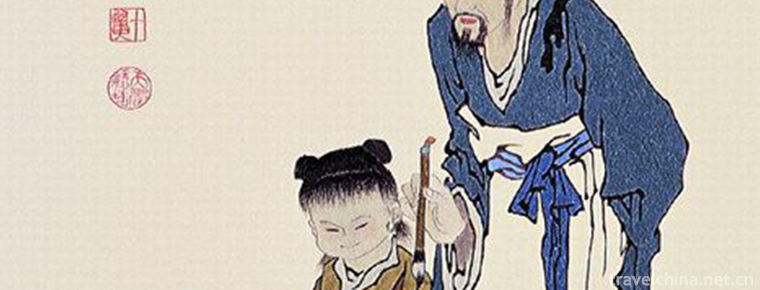

Gu embroidery
-
taste shrimp
Taste shrimp, also known as spicy crayfish, Changsha taste shrimp, spicy crayfish and so on, is a well-known traditional snack in Hunan Province
Views: 223 Time 2018-11-14 -
Old city of Kashi
The old urban area of Kashgar City in Xinjiang is like a living cartoon of Xinjiang Uygur folk customs. The old urban area of Kashgar is located in the centre of Kashgar
Views: 202 Time 2019-01-29 -
Western Royal Tombs of the Qing Dynasty
Xiling Tomb of Qing Dynasty is located at the foot of Yongning Mountain, 15 kilometers west of Yixian Town, Baoding City, Hebei Province, more than 120 kilometers away from Beijing
Views: 233 Time 2019-02-07 -
Di Shu boxing
Gejiquan is one of the rare traditional types of boxing in southern China, also known as "Gejiu Dog Method", "Dilong Quan" or "Dili Quan". It is commonly known as "D
Views: 439 Time 2019-04-26 -
Dong year
In Dong year, Dong language is called Ninggan, also known as Winter Festival or Yang Festival. Winter Festival was originally a festival of Yang surname of Dong nationality.
Views: 357 Time 2019-04-27 -
Mosukun of Oroqen Nationality
Mosukun of Oroqen nationality is Oroqen language, meaning "telling and singing stories". Most of the performances are performed by a single person without accompaniment of musical instrument
Views: 155 Time 2019-04-28 -
Ningbo Zhujin lacquer wood carving
Also known as "Golden Lacquer Wood Carving", it is a traditional Chinese craft. Composition features mainly draw on the advantages of Chinese folk paintings and literati landscape flowers an
Views: 169 Time 2019-06-08 -
Lacquerware Decoration Techniques
Chu-style lacquerware decoration is a traditional folk lacquerware decoration technique. By the Spring and Autumn Period and the Warring States Period, the production technology
Views: 100 Time 2019-06-10 -
Qiang Nationality Year
The Qiang Year is a traditional festival of the Qiang people, also known as the Year of the Youth, which is held on October 1 of the lunar calendar every year. In Maoxian area, there are special regul
Views: 190 Time 2019-06-10 -
Folk Beating and Playing in Zhijiang
Zhijiang folk wind and beating music is a kind of traditional folk music art which is widely active in Zhijiang area of Hubei Province. After years of development and evolution, the folk blowing and p
Views: 266 Time 2019-07-25 -
Rongxian Gaoshiti Forest Park
The landform of Gaoshiti Forest Park is peculiar, with boulders, odd peaks, valleys and streams forming a typical natural landscape of low mountain landform in southern Sichuan. Gaoshiti Forest Park covers a total area of 182.13 hectares. It was approved as a provincial forest park by the provincial forestry department in 1993.
Views: 178 Time 2020-10-15 -
Nanchong hydrology
Nanchong is rich in precipitation. The average annual precipitation is 1000 mm, excluding evaporation, the annual total water is about 4.191 billion cubic meters, and the average annual runoff depth is about 313 mm. The distribution of runoff depth is generally
Views: 364 Time 2020-12-17
